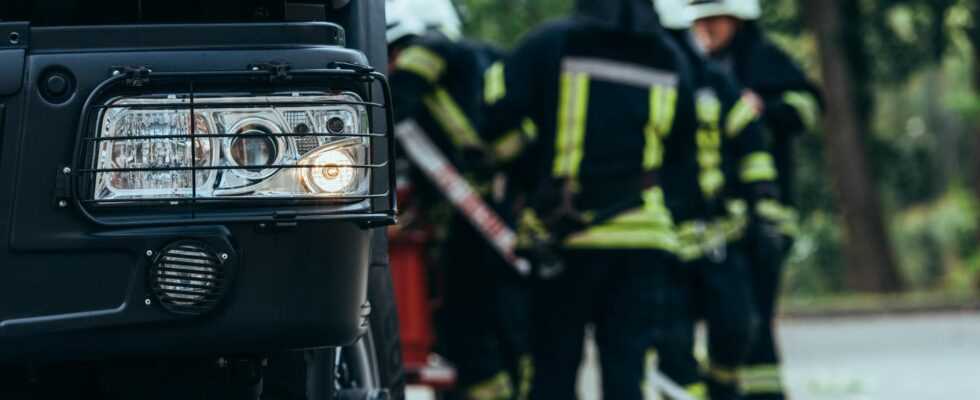Siren alarm and quick commands? Doesn’t necessarily get Thomas Hoppe. He is deaf – and is currently training with the voluntary fire brigade.
“The fire department suits us deaf”
Thomas Hoppe, 52, lives with his wife Kirsten, who is also deaf, and their two children in the district of Pinneberg, Schleswig-Holstein.
My brother is in the volunteer fire brigade in Göttingen – I’ve always envied him. At a festival in our town, a friend then asked me if I would like to visit our volunteer fire brigade.
I was interested in device maintenance, but it wasn’t that easy. In order to be able to take part, you have to be an active member of the fire brigade and also complete the training for this. I thought something like that was forbidden for me. There are no deaf firefighters. But the team from the local volunteer fire brigade worked very hard for me, talked to the authorities and trainers and made a lot of phone calls. There are really a lot of people involved, including friends who have organized the funds for the sign language interpreters to be approved. The whole process took nine months. But there were also friends who were skeptical and said: It will never work, you can’t go to the fire brigade, you won’t hear anything! But I said from the start: I can do it. I think the fire department suits us deaf. We are visual people. I can see immediately where something is broken and can assess situations quickly and accurately. Of course, none of this would be possible without interpreters and the comrades. I understand a lot through facial expressions and posture, but not everything. My comrades are therefore currently learning sign language. This support means a lot to me.
I am a precision mechanic in the metal sector. Since June of this year I’ve been training to become a “squad man”, that’s the first level you have to go through. We learn how to use firefighting water, tie knots, abseil from a balcony and how to cut people out of a vehicle. The course takes place in the evenings and at weekends, and four interpreters take turns supporting me. But I also read a lot on the internet and learn with fire brigade apps. But the practical exercises where you can touch everything are what I enjoy the most. In the meantime I’ve been on two missions, in a traffic accident and in a small fire. However, I remain in the second row. For safety reasons. I understand that – and I can live with that.
“It was a completely new area for me”
Birte Lessing, 42, has been a sign language interpreter for 15 years and is now also an expert in fire brigade matters.
I’ve known the Hoppes for about seven years, I come from the neighboring town, and I sometimes interpret for Thomas and his wife at their children’s parents’ evenings. Since this year I have also been translating for Thomas during his fire brigade training. That’s a challenge and a totally new area for me, very technical, I didn’t even know many of the devices. Before the courses, Maike often sends me YouTube videos so that I can familiarize myself with the topics. If a term comes up during a lecture that I don’t know, my comrades have to show me the part. Sometimes Thomas and I develop completely new fire brigade-specific gestures, for example for the “thing” on which the hoses are rolled up. So that everyone is on the same level, I record new gestures in a video for my colleagues and share it in our group. Four interpreters support Thomas, I take care of scheduling. To be honest, I underestimated the scope of the training at the beginning. I have received the greatest respect for all firefighters in the world.
“Everyone has a talent, everyone can help us”
Maike Bahke, 53, is an assistant fire chief with the Klein Offenseth-Sparrieshoop Volunteer Fire Service, which has 60 active members.
When I heard that Thomas wanted to join us, I wanted to support him. Everyone can help in the fire department, everyone has a talent. You don’t have to be able to do everything. We have therefore established the rule that Thomas does not stand in the absolute danger area during operations, but stands in the second row and always looks for a “Siamese twin” among his comrades, one who is then his “hear”. Thomas shouldn’t be in danger because of something he didn’t hear.
Our fire brigade has existed since 1924. When I joined 18 years ago, I was the first woman, I have risen over the years and have campaigned for us to have a youth fire brigade. I’m a wholesaler full-time, but I also like getting people excited about the fire brigade. A lot of people don’t even know what we’re doing here. There are over a million firefighters in Germany, 93 percent of whom are volunteers. We put out fires, free people from vehicles involved in accidents, save lives and even pull a cat out of a tree.
I have known Thomas for a long time through mutual acquaintances. In the beginning I had to get used to a lot of situations, for example if he has his back to you, you can’t just say something to him. You have to tap him first to be able to communicate with him face to face. So that we can all communicate better with Thomas, our team has taken a beginner’s course in sign language. Next year we will do the advanced course. Sure, that means a lot of extra work for everyone. For example, I showed him things before he started his apprenticeship and made learning cards with devices and terms. But I’m glad he’s with us and I hope that Thomas will eventually be able to train as an equipment manager with the fire brigade.
